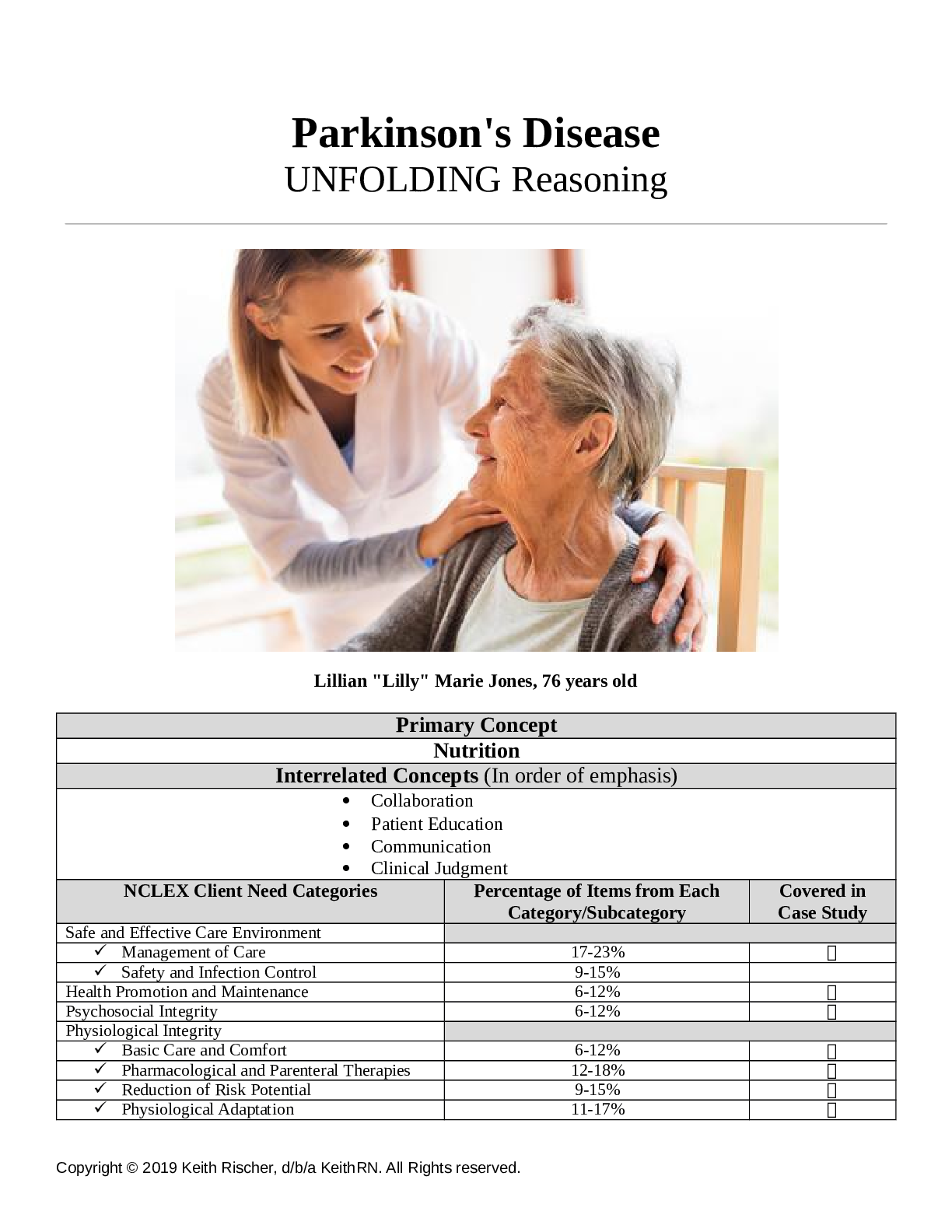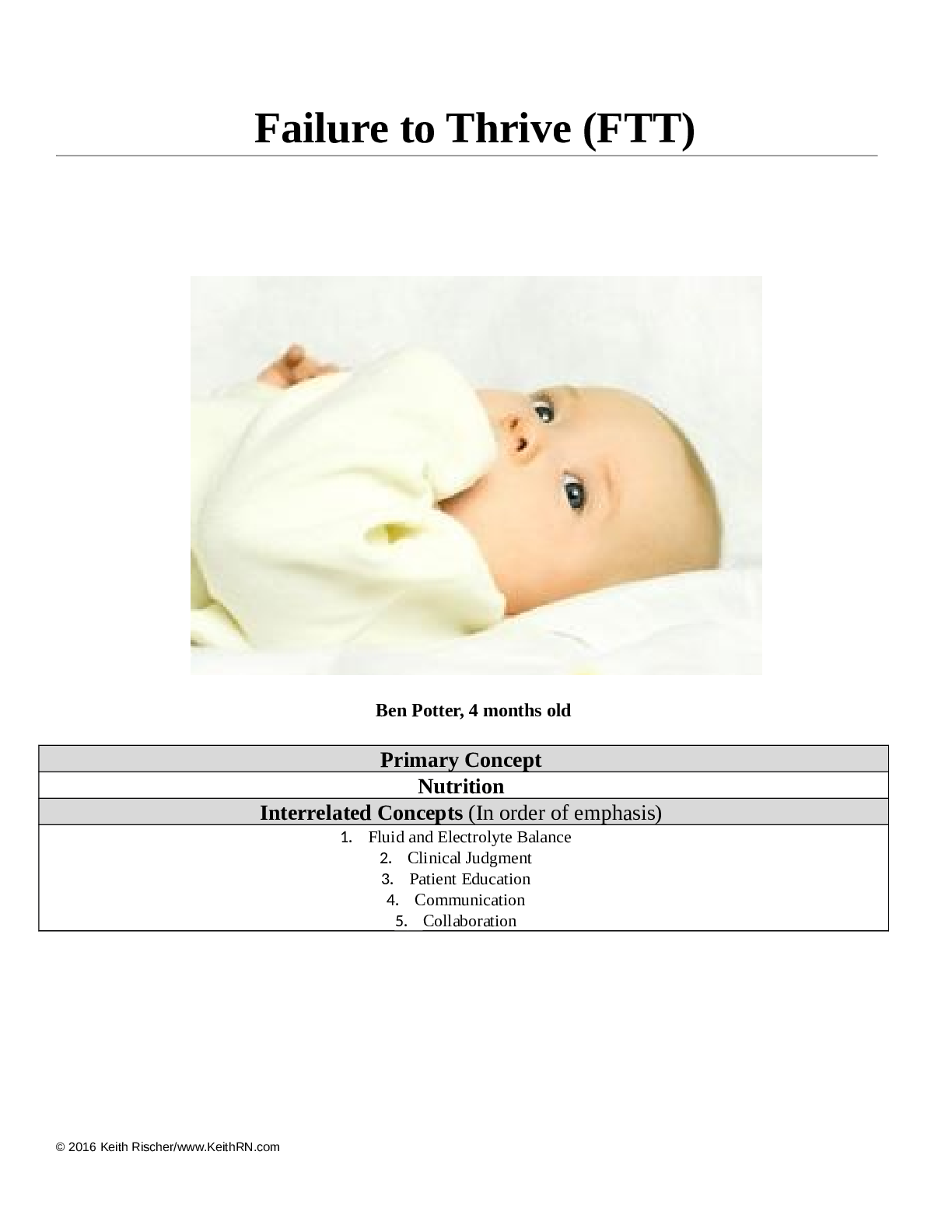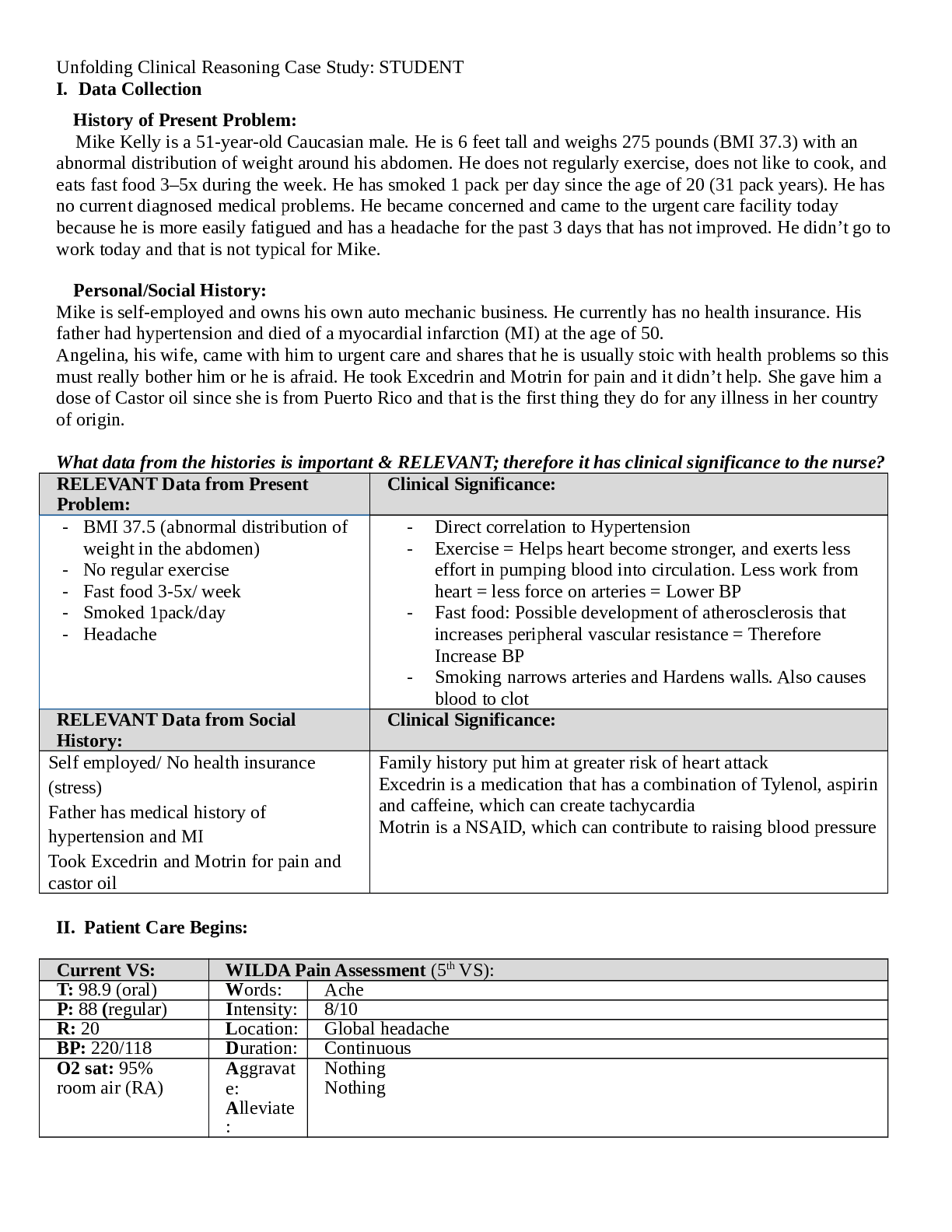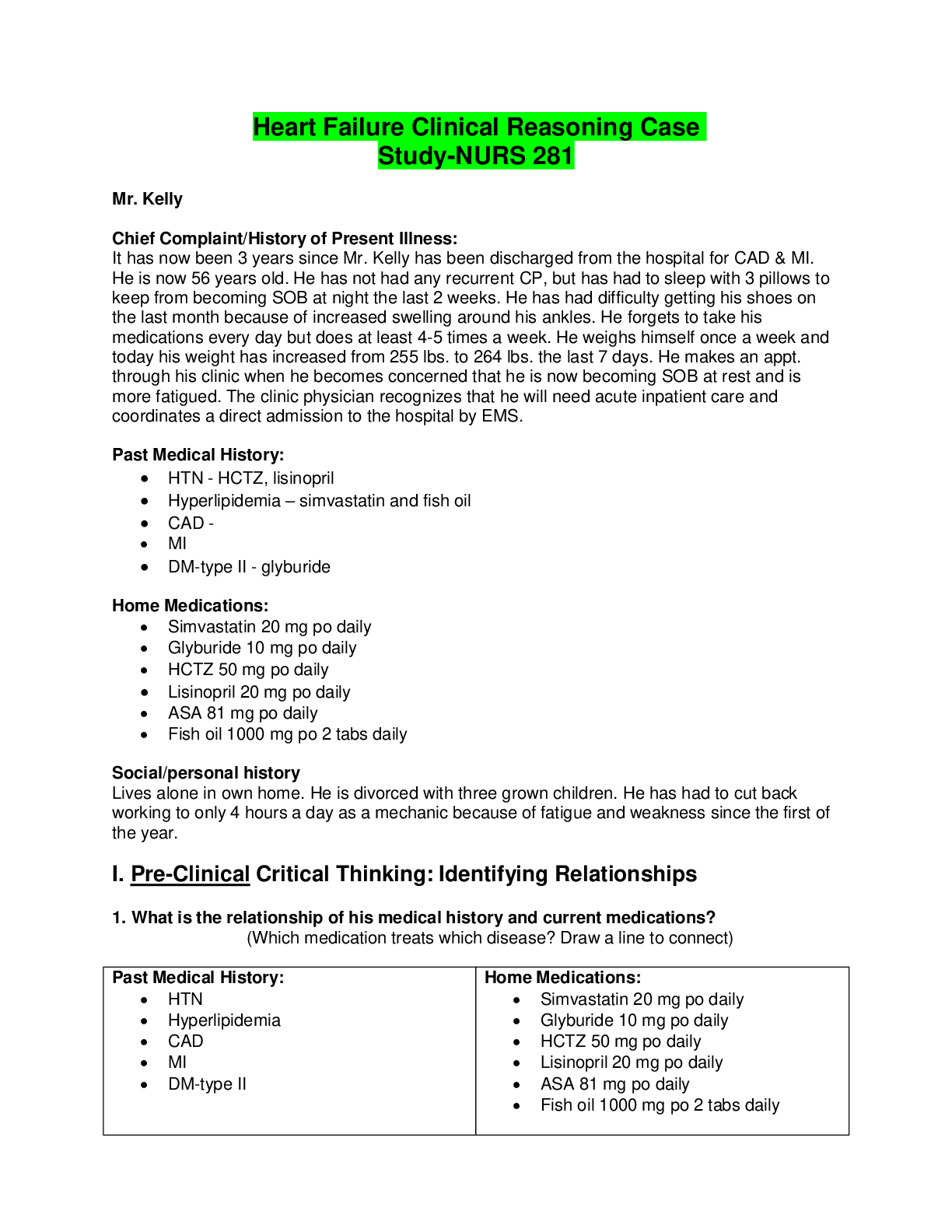*NURSING > CASE STUDY > Parkinsons Disease Clinical Reasoning Case Study/ Parkinson's Disease UNFOLDING Reasoning. Key Compo (All)
Parkinsons Disease Clinical Reasoning Case Study/ Parkinson's Disease UNFOLDING Reasoning. Key Components: 1. Develop Critical Thinking, Clinical Reasoning and Develop Clinical Judgment.
Document Content and Description Below
Case Study Scenario: Lillian “Lilly” Jones is a 76-year-old female with a history of hypertension, gastroesophageal reflux disease (GERD) and Parkinson’s disease. Ms. Jones was hospitalized th... ree months ago due to a urinary tract infection and dehydration. She is now a resident of Sunnyside Health Care Center, a local long-term care facility because her Parkinson’s disease has progressed and her son, Jack, is no longer able to care for her at home. Lilly has lost ten pounds (4.5 kg) in the past month. She is 5 feet-6 inches (167.6 cm) weighs 110 pounds (49.9 kg) and has a BMI of 17.8. After one week of residing at Sunnyside, Jack visits and is saddened when he finds his mother in her room alone. Jack approaches the nursing station and states, “My mother is so thin and losing weight and sits just staring into space. I thought having her here was going to help her get better!” Key Components: 1. Develop Critical Thinking By applying and using knowledge most important to practice 2. Develop Clinical Reasoning By recognizing relevant clinical data to identify the nursing priority 3. Develop Clinical Judgment Outcome when student interprets, notices, and responds appropriately Parkinson's Disease UNFOLDING Reasoning Lillian "Lilly" Marie Jones, 76 years old Primary Concept Nutrition Interrelated Concepts (In order of emphasis) • Collaboration • Patient Education • Communication • Clinical Judgment NCLEX Client Need Categories Percentage of Items from Each Category/Subcategory Covered in Case Study Safe and Effective Care Environment Management of Care 17-23% Safety and Infection Control 9-15% Health Promotion and Maintenance 6-12% Psychosocial Integrity 6-12% Physiological Integrity Basic Care and Comfort 6-12% Pharmacological and Parenteral Therapies 12-18% Reduction of Risk Potential 9-15% Physiological Adaptation 11-17% History of Present Problem: Lillian "Lilly" Jones is a 76-year-old female with a history of hypertension, gastro esophageal reflux disease (GERD) and Parkinson's disease. Ms. Jones was hospitalized three months ago due to a urinary tract infection and dehydration. She is now a resident of Sunnyside Health Care Center, a local long-term care facility because her Parkinson's disease has progressed and her son, Jack, is no longer able to care for her at home. Lilly has lost ten pounds (4.5 kg) in the past month. She is 5 feet-6 inches (167.6 cm) weighs 110 pounds (49.9 kg) and has a BMI of 17.8. After one week of residing at Sunnyside, Jack visits and is saddened when he finds his mother in her room alone. Jack approaches the nursing station and states, "My mother is so thin and losing weight and sits just staring into space. I thought having her here was going to help her get better!” Personal/Social History: Lilly was married to John for 54 years before he passed away two years ago. She has one son, Jack, who lives 30 minutes away. Jack has a medical power of attorney for Lilly's healthcare decisions. Lilly was a homemaker and an active participant in her community. Her hobbies include knitting, playing the piano and reading. Lilly reluctantly has agreed to go to Sunnyside Health Care Center after her son accepted a job that required him to travel. What data from the histories are RELEVANT and must be interpreted as clinically significant by the nurse? (Reduction of Risk Potential) RELEVANT Data from Present Problem: Clinical Significance: 76-year-old female Hx of hypertension, Hx of gastro esophageal reflux disease (GERD) Parkinson's disease Lost ten pounds in the last month, 5 fett-6inches weighs 110 lbs. and BMI of 17.8 Son found his mother in her room alone staring into space RELEVANT Data from Social History: Clinical Significance: Husband, John, passed away two years ago Medical power of attorney, the son Jack, lives 30 minutes away Was a homemaker, an active participant in her community, and had many hobbies. She reluctantly agreed to go to Sunnyside Health Care Center after her son accepted a job that required him to travel. Patient Care Begins: Current VS: P-Q-R-S-T Pain Assessment: T: 98.4 F/36.9 C (oral) Provoking/Palliative: "Better when walking a while." P: 90 (regular) Quality: "ache" R: 14 (regular) Region/Radiation: "Knees" BP: 112/70 Severity: "3/10" O2 sat: 98% room air Timing: "When I wake up." What VS data are RELEVANT and must be interpreted as clinically significant by the nurse? (Reduction of Risk Potential/Health Promotion and Maintenance) RELEVANT VS Data: Clinical Significance: Pain: aching knee pain 3/10 after waking, better when walking a while Pain is part of the body's defense system, producing a reflexive retraction from the painful stimulus, and tendencies to protect the affected body part while it heals, and avoid that harmful situation in the future. Joint pain is common with aging and can be difficult to differentiate from conditions like Arthritis and Parkinson's. Current Assessment: GENERAL SURVEY: NEUROLOGICAL: HEENT: RESPIRATORY: CARDIAC: ABDOMEN: GU: INTEGUMENTARY: What assessment data is RELEVANT and must be interpreted as clinically significant by the nurse? (Reduction of Risk Potential/Health Promotion & Maintenance) RELEVANT Assessment Data: Clinical Significance: General: Alert, flat affect and slow to respond to questions. Sitting with a forward leaning posture. Neuro: Tremors noted at rest in hands. HEENT: tremor noted. Lips, tongue, and oral mucosa pink and tacky dry. Abdomen: BS hypoactive in all four quadrants. GU: Urinary Incontinent episode x1, urine yellow Integumentary: tenting present Lab Results-On Admission: Complete Blood Count (CBC) WBC HGB PLTs % Neuts Bands Current: 8.5 10.8 154 65 0 Last Month: 6.4 12.8 208 55 0 What lab results are RELEVANT and must be recognized as clinically significant by the nurse? (Reduction of Risk Potential/Physiologic Adaptation) RELEVANT Lab(s): Clinical Significance: TREND: Improve/Worsening/Stable: WBC: 8.5 Hgb: 10.8 PLTs: 154 Neuts: 65% Bands: 0 Basic Metabolic Panel (BMP) Na K Gluc. Creat. BUN Current: 142 3.7 88 1.4 38 Last Month: 135 3.4 90 1.0 22 What lab results are RELEVANT and must be recognized as clinically significant by the nurse? (Reduction of Risk Potential/Physiologic Adaptation) RELEVANT Lab(s): Clinical Significance: TREND: Improve/Worsening/Stable: Na: 142 K: 3.7 Gluc.: 88 Creat.: 1.4 BUN: 38 Liver Panel Albumin Total Bili Alk. Phos. ALT AST Current: 3.0 1.1 70 12 20 Last Month: 3.6 1.0 68 14 20 What lab results are RELEVANT and must be recognized as clinically significant by the nurse? (Reduction of Risk Potential/Physiologic Adaptation) RELEVANT Lab(s): Clinical Significance: TREND: Improve/Worsening/Stable: Albumin: 3.0 Total Bili: 1.1 Alk Phos: 20 ALT: 12 AST: 20 Urinalysis + UA Micro: Clean Catch Specimen Color: Clarity: Sp. Gr. Protein Glucose Ketones Nitrite LET RBCs WBCs Bacteria Epi. Current: yellow dark 1.030 Neg Neg Neg Neg Neg 0 0 none none Last Month: yellow clear 1.015 Neg Neg Neg Neg Neg 0 0 none none What lab results are RELEVANT and must be recognized as clinically significant by the nurse? (Reduction of Risk Potential/Physiologic Adaptation) RELEVANT Lab(s): Clinical Significance: TREND: Improve/Worsening/Stable: Color: yellow Clarity: dark Sp. Gr.: 1.030 Protein: Neg Glucose: Neg Ketones: Neg Nitrite: Neg LET: Neg RBCs: 0 WBCs: 0 Bacteria: none Epi.: none Lab Planning: Creating a Plan of Care with a PRIORITY Lab: (Reduction of Risk Potential/Physiologic Adaptation) Lab: Normal Value: Clinical Significance: Nursing Assessments/Interventions Required: Albumin Value: 3.0 g/dL 3.4 to 5.4 g/dL Critical Value: <2.0 g/dL, >5.4 g/dL Clinical Reasoning Begins… 1. Interpreting relevant clinical data, what is the primary problem? What primary health-related concepts does this primary problem represent? (Management of Care/Physiologic Adaptation) Problem: Pathophysiology of Problem in OWN Words: Primary Concept: Collaborative Care: Medical Management (Pharmacologic and Parenteral Therapies) Care Provider Orders: Rationale: Expected Outcome: PRIORITY Setting: Which Orders Do You Implement First and Why? (Management of Care) Care Provider Orders: Order of Priority: Rationale: • 1) 1) Collaborative Care: Nursing 2. What nursing priority (ies) will guide your plan of care? (Management of Care) Nursing PRIORITY: Imbalance of nutrition: less than body requirements PRIORITY Nursing Interventions: Rationale: Expected Outcome: • 3. What body system(s) will you assess most thoroughly based on the primary/priority concern? (Reduction of Risk Potential/Physiologic Adaptation) PRIORITY Body System: PRIORITY Nursing Assessments: • • 4. What is the worst possible/most likely complication(s) to anticipate based on the primary problem of this patient? (Reduction of Risk Potential/Physiologic Adaptation) Worst Possible/Most Likely Complication to Anticipate: Reduced muscle and tissue mass/ decreased mobility and stamina as a result of muscle wasting Nursing Interventions to PREVENT this Complication: Assessments to Identify Problem EARLY: Nursing Interventions to Rescue: • • 5. What psychosocial/holistic care PRIORITIES need to be addressed for this patient? (Psychosocial Integrity/Basic Care and Comfort) Psychosocial PRIORITIES: PRIORITY Nursing Interventions: Rationale: Expected Outcome: CARE/COMFORT: Caring/compassion as a nurse EMOTIONAL (How to develop a therapeutic relationship): Discuss the following principles needed as conditions essential for a therapeutic relationship: SPIRITUAL: • F-Faith or beliefs: • I-Importance and influence • C-Community: • A-Address: CULTURAL Considerations (IF APPLICABLE) Evaluation: Three weeks later… Current VS: One Week Ago: Current PQRST: T: 98.0 F/36.9 C (oral) T: 98.4 F/36.9 C (oral) Provoking/Palliative: P: 70 (regular) P: 78 (regular) Quality: R: 14 (regular) R: 16 (regular) Region/Radiation: no pain today BP: 120/78 BP: 118/68 Severity: O2 sat: 99% room air O2 sat: 98% room air Timing: Weight: 112 lbs/50.9 kg Weight: 110 lbs/49.9 kg Current Assessment: GENERAL SURVEY: NEUROLOGICAL: HEENT: RESPIRATORY: CARDIAC: ABDOMEN: GU: INTEGUMENTARY: 1. What data is RELEVANT and must be interpreted as clinically significant by the nurse? (Reduction of Risk Potential/Health Promotion and Maintenance) RELEVANT VS Data: Clinical Significance: TREND: Improve/Worsening/Stable: • • • RELEVANT Assessment Data: Clinical Significance: TREND: Improve/Worsening/Stable: 2. Has the status improved or not as expected to this point? Does your nursing priority or plan of care need to be modified in any way after this evaluation assessment? (Management of Care, Physiological Adaptation) Evaluation of Current Status: Modifications to Current Plan of Care: 3. Based on your current evaluation, what are your CURRENT nursing priorities and plan of care? (Management of Care) CURRENT Nursing PRIORITY: Promote safety and prevent infection PRIORITY Nursing Interventions: Rationale: Expected Outcome: It is now the end of your shift. Effective and concise handoffs are essential to excellent care and, if not done well, can adversely impact the care of this patient. You have done an excellent job to this point; now finish strong and give the following SBAR report to the nurse who will be caring for this patient: (Management of Care) Situation: Name/age: Lillian "Lilly" Marie Jones, 76 years old BRIEF summary of the primary problem: Lilly has lost ten pounds (4.5 kg) in the past month. Day of admission/post-op #: Background: Primary problem/diagnosis: RELEVANT past medical history: RELEVANT background data: Assessment: Most recent vital signs: RELEVANT body system nursing assessment data: RELEVANT lab values: No recent lab values TREND of any abnormal clinical data (stable-increasing/decreasing): How have you advanced the plan of care?. Patient response INTERPRETATION of current clinical status (stable/unstable/worsening): Recommendation: Suggestions to advance the plan of care: Education Priorities/Discharge Planning What educational/discharge priorities will be needed to develop a teaching plan for this patient and/or family? (Health Promotion and Maintenance) Education PRIORITY: PRIORITY Topics to Teach: Rationale: Caring and the “Art” of Nursing What is the patient likely experiencing/feeling right now in this situation? What can you do to engage yourself with this patient’s experience, and show that he/she matters to you as a person? (Psychosocial Integrity) What Patient is Experiencing: How to Engage: Use Reflection to THINK Like a Nurse What did you learn that you can apply to future patients you care for? Reflect on your current strengths and weaknesses this case study identified. What is your plan to make any weakness a future strength? What Did You Learn? What did you do well in this case study? What could have been done better? What is your plan to make any weakness a future strength? Med Cards Ranitidine (Zantac) • Drug Class: • Therapeutic Action: • Indications: Dosages: GERD—150 mg twice daily • Pharmacokinetics: o Half-life: 2-2.5 hr • Contraindications: • Use Cautiously in: • Adverse Effects: • Nursing Considerations: • Relevant labs: • Client Teaching: Carbidopa-Levodopa • Route O Onset Peak Duration 1 • Contraindications: • Adverse Effects: • Nursing Considerations: • Relevant labs: . • Client Teaching: [Show More]
Last updated: 1 month ago
Preview 1 out of 18 pages

Reviews( 0 )
Recommended For You
Health Care> CASE STUDY > Pediatric Nursing Unfolding Clinical Reasoning CASE STUDY FAILURE TO THRIVE Ben Potter 4 Months Old (All)

Pediatric Nursing Unfolding Clinical Reasoning CASE STUDY FAILURE TO THRIVE Ben Potter 4 Months Old
Pediatric Nursing Unfolding Clinical Reasoning CASE STUDY FAILURE TO THRIVE Ben Potter 4 Months OldPediatric Nursing Unfolding Clinical Reasoning CASE STUDY FAILURE TO THRIVE Ben Potter 4 Months OldPe...
By Doctor Immanuel , Uploaded: Aug 03, 2022
$12
*NURSING> CASE STUDY > Airway Breathing (Oxygenation) Pneumonia Chronic Obstructive Pulmonary Disease Clinical Reasoning Case Study Medical surgical (NUR 201) Pneumonia-COPD case study solutions (All)
.png)
Airway Breathing (Oxygenation) Pneumonia Chronic Obstructive Pulmonary Disease Clinical Reasoning Case Study Medical surgical (NUR 201) Pneumonia-COPD case study solutions
Airway Breathing (Oxygenation) Pneumonia Chronic Obstructive Pulmonary Disease Clinical Reasoning Case Study Medical surgical (NUR 201) Pneumonia-COPD case study solutions JoAnn Walker is an 84-year-o...
By ExpertAnswer , Uploaded: Jul 26, 2022
$13.5
*NURSING> CASE STUDY > Narcotics or Sepsis? Pharmacology Clinical Reasoning Case Study- NURSING RN 101 (All)
Narcotics or Sepsis? Pharmacology Clinical Reasoning Case Study- NURSING RN 101
History of Present Problem: Brian Sanders is a 34-year-old male who was evaluated in the emergency department (ED) earlier this morning for an abscess that was drained from his left thigh. He was giv...
By Studyrepository , Uploaded: Jun 07, 2022
$11
Health Care> CASE STUDY > Unfolding Clinical Reasoning Case Study graded and approved 100% (All)

Unfolding Clinical Reasoning Case Study graded and approved 100%
Mike Kelly is a 51-year-old Caucasian male. He is 6 feet tall and weighs 275 pounds (BMI 37.3) with an abnormal distribution of weight around his abdomen. He does not regularly exercise, does not lik...
By APLUSMASTER , Uploaded: May 07, 2022
$7
Health Care> CASE STUDY > Airway/Breathing (Oxygenation) Pneumonia/Chronic Obstructive Pulmonary Disease Clinical Reasoning Case Study (All)
 PneumoniaChronic.png)
Airway/Breathing (Oxygenation) Pneumonia/Chronic Obstructive Pulmonary Disease Clinical Reasoning Case Study
Airway/Breathing (Oxygenation) Pneumonia/Chronic Obstructive Pulmonary Disease Clinical Reasoning Case Study Airway/Breathing (Oxygenation) Pneumonia/Chronic Obstructive Pulmonary Disease Clinical...
By Doctor Immanuel , Uploaded: Apr 28, 2022
$14
*NURSING> CASE STUDY > Airway/Breathing (Oxygenation) Pneumonia/Chronic Obstructive Pulmonary Disease Clinical Reasoning Case Study (All)

Airway/Breathing (Oxygenation) Pneumonia/Chronic Obstructive Pulmonary Disease Clinical Reasoning Case Study
Airway/Breathing (Oxygenation) Pneumonia/Chronic Obstructive Pulmonary Disease Clinical Reasoning Case Study STUDENT Worksheet JoAnn Walker, 84 years old Overview This case study incorporates a...
By Nutmegs , Uploaded: Apr 14, 2022
$14
*NURSING> CASE STUDY > Heart Failure Clinical Reasoning Case Study-NURS 281 (All)

Heart Failure Clinical Reasoning Case Study-NURS 281
Mr. Kelly Chief Complaint/History of Present Illness: It has now been 3 years since Mr. Kelly has been discharged from the hospital for CAD & MI. He is now 56 years old. He has not had any recurre...
By Studyrepository , Uploaded: Apr 06, 2022
$13
*NURSING> CASE STUDY > Unfolding clinical reasoning case study- CLINICALS VN130 .pdf (All)
Unfolding clinical reasoning case study- CLINICALS VN130 .pdf
I. Initial Presentation: Susan Jones is a 42-year-old African-American female with a past medical history of diabetes mellitus type II. She works in a manufacturing plant in her hometown. While at w...
By Studyrepository , Uploaded: Mar 19, 2022
$8
*NURSING> CASE STUDY > Unfolding Clinical Reasoning Case Study (All)

Unfolding Clinical Reasoning Case Study
Unfolding Clinical Reasoning Case Study
By BRAINEDGE , Uploaded: Feb 26, 2022
$11
*NURSING> CASE STUDY > Heart Failure Clinical Reasoning Case Study 2-Southwest Tennessee Community College (All)

Heart Failure Clinical Reasoning Case Study 2-Southwest Tennessee Community College
Heart Failure Clinical Reasoning Case Study- Carlos Boccerini,68 yrs old/Heart Failure Clinical Reasoning Case Study- Carlos Boccerini,68 yrs old Carlos Boccerini is a 68-year-old male who has a 5-yea...
By Studyrepository , Uploaded: Feb 03, 2022
$13
Document information
Connected school, study & course
About the document
Uploaded On
Mar 09, 2021
Number of pages
18
Written in
Additional information
This document has been written for:
Uploaded
Mar 09, 2021
Downloads
1
Views
99






